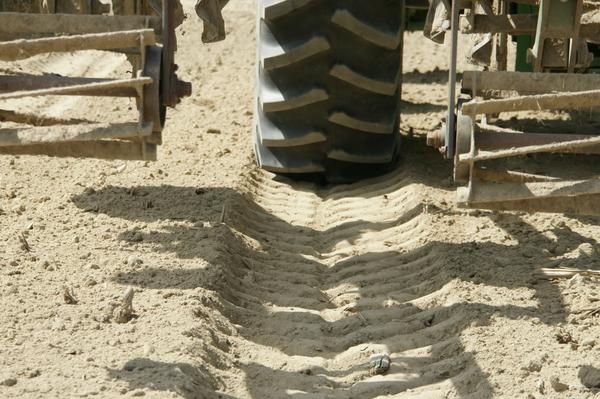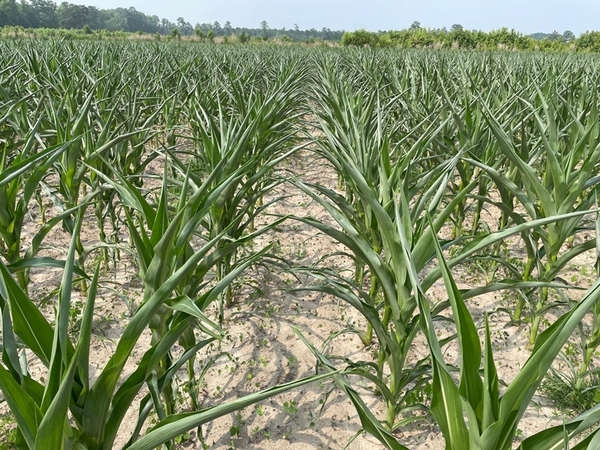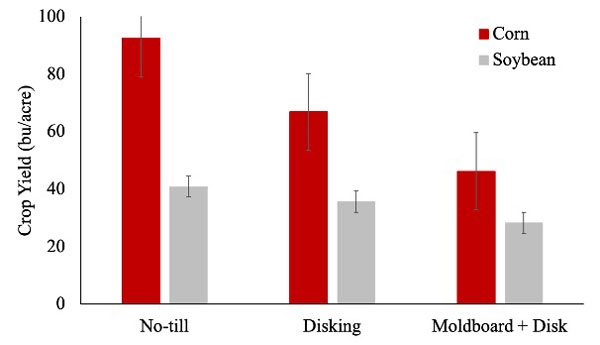Introduction
Soil compaction is one of the most common issues that contribute to soil degradation in modern agriculture. Soil compaction is a process that reduces the space between soil particles, which then limits air and water movement within the soil. Soil compaction limits root growth, which decreases available water to the crop and also reduces nutrient uptake. Agricultural practices such as the use of heavy agricultural machinery and tillage management, as well as substantial field traffic, rainfall, and livestock cause most soil compaction. Across the sandy soils of the coastal plain, compaction is a problem for farmers, who experience noticeable reduction in crop yields.
North Carolina Soils Sensitive to Compaction
Many North Carolina soils are susceptible to compaction, especially those that are classified as ultisol. Ultisols are old soils that are formed by intense weathering and the leaching of clay particles and nutrients. These processes result in sandy surface layers that are easily compacted and hold low amounts of water that are available to the plants. In addition, the soils have high clay contents in the subsoil, which is below the sandy topsoil and which hold most of the available water for plants. Ultisols have low base saturation, low soil organic matter content, and weak soil structure. Low base saturation means that the soils naturally hold low amounts of essential plant nutrients such as potassium, calcium, and magnesium. The soils tend to be acidic. Given these characteristics, ultisols require regular applications of fertilizer and lime in order to achieve economical crop yields.
The sandy topsoil layers are the most prone to compaction. Rainfall can compact the surface and create hard soil crusts. These dense layers reduce yields by preventing seedlings from emerging. In addition, the wheels of tractors and plows create compact soil layers within and near the base of the sandy topsoil layers that are commonly called hard pans. These layers prevent crop roots from reaching the available water stored in the underlying clay layers and reduce yields during dry years. Soil crusts and hardpans are found most often in the coastal plain.
Agricultural Machinery and Traffic Induced Compaction
To maintain the productivity of modern agriculture, machinery is required for farm operations such as planting, spraying, and harvesting. The wheels of these implements compress and compact the soil beneath them. Most soil compaction occurs during the first pass of machinery (Botta et al. 2009), as shown in Figure 1.
Farmers can limit traffic induced compaction by avoiding field operations when the soil is wet and has low soil strength or resistance to compaction. Performing field operations when soils are dry decreases soil compaction because the drier soils have a higher soil strength and greater resistance to compaction. Limiting the axle loads of farm equipment can also reduce compaction in the field. The pressure a tire exerts on the soil is roughly equal to its air pressure. Thus, monitoring and controlling the tire pressure can help with soil compaction. Reducing the amount of times machinery travels through the fields can also reduce the soil compaction. Using wider sprayers and transitioning to no-till reduces the travel of the machinery. In addition, traffic lane designs and GPS systems that control where traffic occurs can also reduce the compaction.
Controlled traffic farming can be a powerful tool to prevent compaction. Without GPS-enabled machinery, it is challenging to keep accurate records of traffic patterns that occur over time with different types of field operations. Controlling traffic may not be practical for all farmers until current technology is available in every farm operation.
Tillage Induced Compaction
Intense tillage practices such as disking and chisel or moldboard plowing are not recommended. Over time, these practices decrease soil organic matter, soil structure, and water holding capacity. Figure 2 shows the consequences of long-term intense tillage in the coastal plain of North Carolina. The soil has weak structure and low organic matter, and the crops are water stressed.
Intense tillage practices at the same depth can promote faster development of a hard pan over time. Hard pans are compacted layers of soil in the subsurface that restrict root growth and are usually caused by long-term field traffic even under conservative management. An example of a hard pan is shown in Figure 3 which was formed by 25 to 40 years of soil use with no-till. With conventional management, soils form a much harder compacted subsurface layer in three to four years. The root growth stops abruptly at the hardpan with both conventional tillage (Figure 2) and no-till management (Figure 3). As seen in Figure 2, soils with conventional tillage management have much weaker soil structure and lower soil organic matter above the hardpan layer compared to soils with no-till management. Figure 3 shows a hard pan in a long-term no-till field in coastal plain, North Carolina. Hard pans are particularly harmful to crop growth in dry years by limiting the crop’s access to water and nutrients (Vepraskas and Guthrie 1992).
To prevent the formation of hard pans, tillage should be avoided (Figure 4). When tillage is necessary, the less intense tillage types, such as strip tilling, should be done when the soil is not wet. Soils that are tilled when there is higher moisture content in the soil will become more compacted. More intense tillage methods such as disking and moldboard plowing should be avoided. Soil ripping is the best option for breaking apart the hard pan. However, ripping does not always have a positive effect on crop yields. To increase the likelihood that ripping will increase crop yields, ripping should be done only on soils with high bulk density and high penetration resistance in the sublayer (Vepraskas et al. 1987).
Figure 5 shows how a corn crop with long-term conventional tillage and no irrigation is stressed due to weak soil structure. The crop will have weak crop biomass and low yield. In general, soils with no-till have higher soil organic matter contents, better soil structure, higher porosity, good pore size distribution, and balanced air and water content compared to those under conventional tillage management.
Recommendations for Mitigating Compaction
A single management strategy cannot effectively eliminate compaction. No-till is often recommended to alleviate compaction, although it cannot eliminate a hard pan. Therefore, several strategies are needed to effectively manage compaction.
When practicable, control traffic. Driving machinery in controlled lanes in the field and limiting all future traffic in this pattern may help reduce compaction. In this way, compact soil layers will form beneath the tires, but will not extend laterally across the field. It is important to match tire widths so that the same soil is compacted with each pass. It is also important to refrain from using machinery on wet soils, maintain appropriate tire pressure, and maintain axle loads below 10,000 lb. This will prevent sub-horizon compaction and limit compaction to the soil surface. If possible, invest in GPS and precision farming technology.
No-till is an effective management strategy to mitigate compaction. Transitioning from more intensive tillage, such as chisel plow and disking, to no-till results in higher soil carbon content, lower soil strength, and more soil aggregation (Meijer et al. 2013). Decreasing the intensity and frequency of the tillage, along with adding living organic matter and cover cropping, could also promote the soil structural development and increased storage of organic matter. These changes help to create soil that is less compacted and more resistant to future compaction. A 28-year study in the piedmont of North Carolina showed the benefits of no-till on average crop yields (Figure 6). No-till yielded higher than the more intense tillage methods, with corn receiving a greater benefit from no-till when compared to soybean.
Earlier studies showed that no-till had higher yields than conventional tillage methods in the piedmont (Wagger and Denton 1992). In this five-year study, no-till had 27% higher corn yields when compared to chisel plowing. However, in this same study, soybean yield was not influenced by tillage method.
The influence of no-till management may be more significant because less disturbance of the soil surface layers helps well-drained piedmont soils have better soil structure and less erosion on the steeper slope soils. No-till management will also encourage accumulation of organic matter, higher clay content, and protection of organic matter from decomposition in smaller pores. No-till effects in the coastal plain may not be as significant as in piedmont because of the thick sandy and weakly structured surface soils (ranges from 6 to 20 in.), which are right above subsoils that are clay rich and low in organic matter content. Thus, the effects of no-till management are less evident in coastal plain soils, which are less resistant to compaction.
Conclusion
Compaction is a common problem for farmers in North Carolina. To reduce compaction, avoid field operations when soil is wet. Keep axle loads under 10,000 lb, and be sure that tires are properly inflated. Reducing the number of passes over the field and controlling traffic will also help to reduce the compaction. Use soil ripping to break apart any hard pans. Shifting from conventional tillage to less intensive tillage methods can help to alleviate compaction and make the soil more resistant to future compaction.
References
Botta, G.F., A. Tolón-Becerra, and F. Bellora Tourn. 2009. “Effect of the Number of Tractor Passes on Soil Rut Depth and Compaction in Two Tillage Regimes.” Soil and Tillage Research 103, no.2: 381–386. ↲
Mathers, Cara, Joshua L. Heitman, Anders Huseth, Anna Locke, Deanna Osmond, and Alexander Woodley. 2023. “No-till Imparts Yield Stability and Greater Cumulative Yield under Variable Weather Conditions in the Southeastern USA Piedmont.” Field Crops Research 292: 108891. ↲
Meijer, Alan, Josh L. Heitman, Jeffrey G. White, and Rob E. Austin. 2013. “Measuring Erosion in Long-Term Tillage Plots Using Ground-Based Lidar.” Soil and Tillage Research 126: 1–10. ↲
Vepraskas, Michael J. and D. S. Guthrie. 1992. “Identifying Soils Where Subsoiling Can Increase Yields of Tobacco, Corn, and Cotton.” Journal of Production Agriculture 5, no.4: 482–488. ↲
Vepraskas, Michael J., G. S. Miner, and G. F. Peedin. 1987. “Relationships of Soil Properties and Rainfall to Effects of Subsoiling on Tobacco Yield 1.” Agronomy Journal 79, no. 1: 141–146. ↲
Wagger, Michael G., and H. P. Denton. 1992. “Crop and Tillage Rotations: Grain Yield, Residue Cover, and Soil Water.” Soil Science Society of America Journal 56, no.4: 1233–1237. ↲
Publication date: Dec. 18, 2023
AG-439-72
N.C. Cooperative Extension prohibits discrimination and harassment regardless of age, color, disability, family and marital status, gender identity, national origin, political beliefs, race, religion, sex (including pregnancy), sexual orientation and veteran status.






